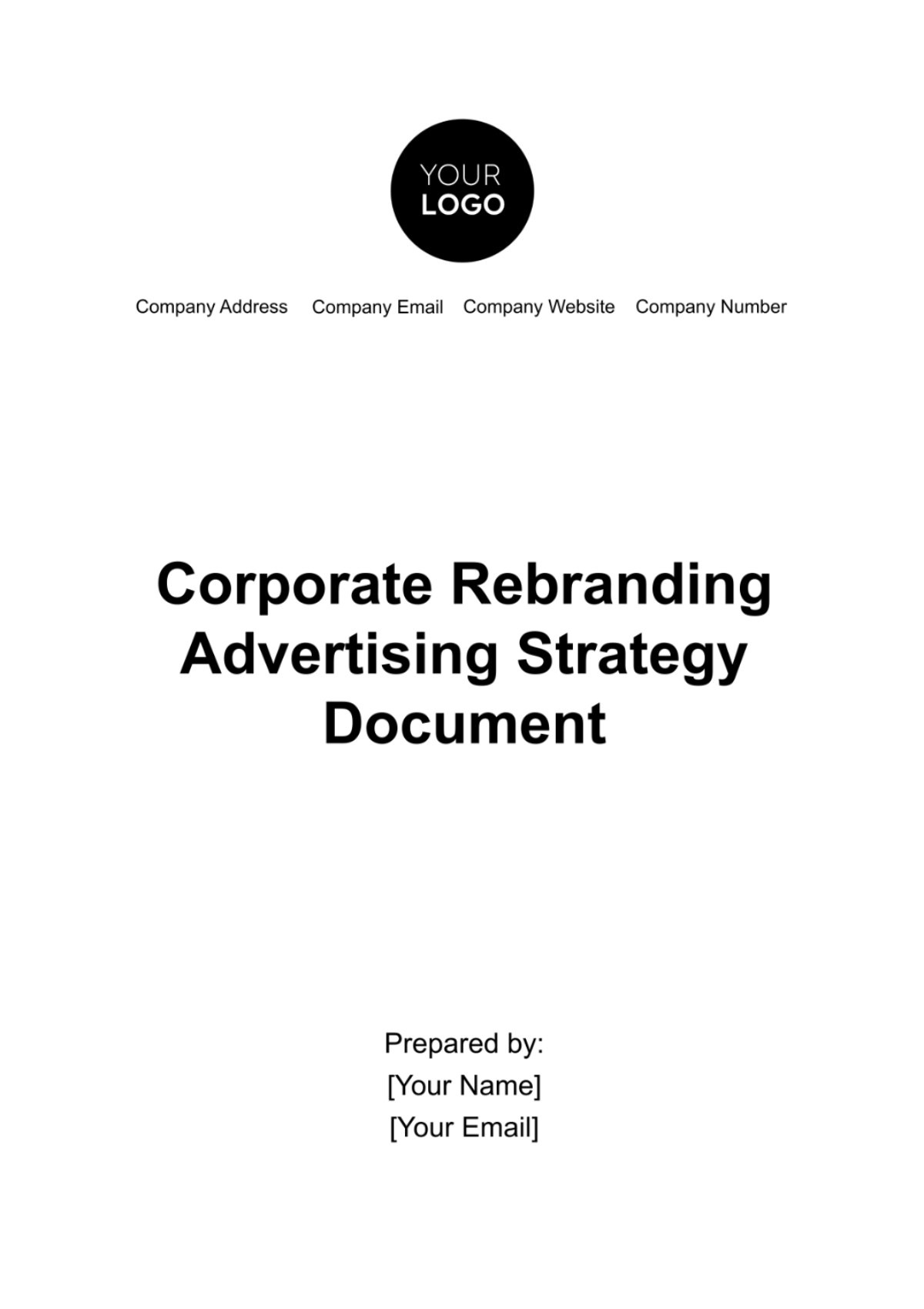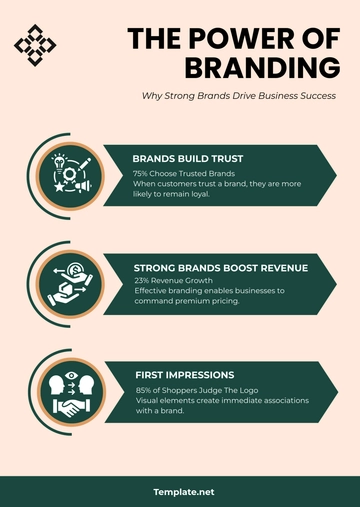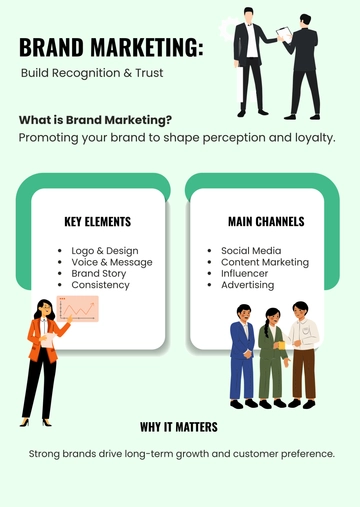Free Corporate Rebranding Advertising Strategy Document

I. Introduction to Rebranding
This section sets the stage for the rebranding initiative, offering insight into why the rebranding is happening and what it aims to achieve. It's crucial to articulate the motivations behind the change, whether it's to realign with a new market position, refresh the brand image, or reflect significant changes within the company.
The Need for Change:
Begin by addressing why rebranding is necessary. For instance, "In response to evolving market trends and consumer preferences, we recognize the need to rejuvenate our brand to stay relevant and competitive."
Legacy and Evolution:
Reflect on the brand’s legacy. "For over [00] years, [Brand Name] has been a leader in [industry], but to continue our growth, we need to evolve."
Future Vision:
Describe what the rebrand aims to achieve. "This rebranding is not just a change of our visual identity; it’s a recommitment to our core values, with a renewed focus on innovation and customer-centric solutions."
Stakeholder Engagement:
Emphasize the importance of bringing all stakeholders on board. "A series of workshops and meetings with our employees, partners, and key customers will be conducted to gather insights and foster a sense of ownership in the rebranding process."
Communications Plan:
Outline a communications strategy to introduce the rebranding to the market. "We will launch a multi-channel campaign to communicate our new brand story, focusing on our heritage, the changes we are making, and what this means for our customers."
II. New Brand Identity Overview
In this section, unveil the new brand identity elements, describing each component and the thought process behind these changes. The new identity should reflect the brand's future direction and values while maintaining a connection with its heritage.
A. Description of New Identity
The new logo is a green and blue globe, symbolizing the brand’s commitment to sustainability and its global reach. The typography is modern and clean, reflecting innovation and accessibility. The color scheme includes earth tones to represent eco-friendliness and bright blues for technological advancement.
B. Rationale Behind the Choices
The globe symbolizes the brand’s global vision and environmental focus. The color scheme was chosen to resonate with eco-conscious consumers and to stand out in the tech industry, typically dominated by monochrome colors.
C. Visuals and Examples
Provide mock-ups of the new logo on product packaging, business cards, and digital platforms. Show how the new color scheme will be used in advertising materials and the brand website. Comparisons with the old branding can demonstrate the evolution and modernization of the brand.
III. Target Audience Analysis
Understanding and defining the target audience is crucial for the success of the rebranding campaign. This section should detail the current audience demographics and psychographics, and explain how the rebranding will appeal to the new or existing target audience.
A. Current Audience Profile
The current audience primarily consists of middle-aged professionals who value quality and reliability in technology. They have been loyal to the brand due to its long-standing reputation in the tech industry.
B. Intended Audience Analysis
The intended audience includes environmentally conscious millennials and Gen Z consumers who prioritize sustainability in their purchasing decisions. This demographic is tech-savvy and looks for brands that align with their values.
C. Alignment with New Branding
The new branding aims to retain the current customer base by emphasizing improved quality and innovation while attracting new customers through its commitment to sustainability. Marketing campaigns will highlight the brand’s new eco-friendly initiatives and products, showcasing how they meet the needs and values of the younger demographic.
IV. Brand Positioning and Messaging
The rebranding should result in a clear, new positioning of the brand in the market, reflected in every message communicated to the audience. This section is about defining how the rebranding will change the brand's perception and the key messages that will be conveyed.
A. Revised Brand Positioning Statement
"Leading the way in sustainable technology for a smarter future."
This positioning statement emphasizes the brand’s commitment to leading the market in eco-friendly technology solutions.
B. Key Messaging Points
Messages will focus on innovation, sustainability, and customer-centric design. For example, advertising campaigns might use slogans like "Innovate for a Green Tomorrow" or "Technology that Cares for the Planet."
C. Brand Voice Guidelines
The brand voice will shift to be more youthful, dynamic, and inspiring. It should communicate enthusiasm for technology and sustainability, appealing to the values and aspirations of the younger target audience.
V. Marketing and Communication Strategy
A comprehensive marketing and communication strategy is essential to introduce the rebranded identity to the market effectively. This strategy should encompass various channels and tactics to ensure widespread and impactful communication.
A. Marketing Strategies
Outline the overall marketing strategies for launching the rebrand. This might include a mix of digital marketing, content marketing, influencer collaborations, and offline events.
B. Communication Channels
Specify the channels to be used for the rebranding campaign. Digital channels might include social media, email marketing, and digital ads, while traditional channels could be TV, radio, and print media.
C. Tactics and Approaches
Detail specific tactics for each channel. For instance, social media campaigns could involve teaser posts, countdowns to the rebrand launch, and interactive content to engage the audience.
VI. Creative Strategy for Advertising
The creative strategy for advertising the rebrand is crucial for capturing the audience's attention and communicating the new brand identity. This strategy should detail the conceptualization and execution of the advertising content.
A. Guidelines for Creative Concept Development
Developing creative concepts that embody the new brand identity and effectively communicate the rebranding message is pivotal. These concepts should encapsulate the essence of the brand's new direction while maintaining a connection with its heritage.
Storytelling and Emotional Appeal: Weave storytelling into the creative concepts to make an emotional connection with the audience. Narratives could focus on the journey of the brand, highlighting key milestones and how they have led to the present rebranding. Emotional appeal can be achieved by showcasing the brand's commitment to values that resonate with the target audience, like sustainability or innovation.
Showcasing Evolution: Use the creative concepts to illustrate the brand's evolution. This can involve a comparative display of past and present, showing how the brand has grown and why the rebranding is a natural progression of its journey. The concept can also include customer stories or testimonials that reflect the positive impact of the brand over time.
Innovative and Engaging Concepts: Push for innovative ideas that stand out in the crowded advertising space. Concepts should be engaging and memorable, prompting the audience to think about the brand in a new light. Use interactive elements, digital innovations, or experiential marketing tactics to bring the rebranding message to life.
B. Visual Elements
The visual elements in the advertising campaign play a critical role in reinforcing the new brand identity. They are the most immediate and impactful way the audience will engage with the rebranding.
Alignment with New Brand Identity: Ensure that all visual elements are in harmony with the new brand identity. This includes consistent use of the new logo, color palette, and typography across all advertising materials. The visuals should reflect the brand's new personality – whether it’s more modern, sophisticated, or vibrant.
Imagery and Design: Choose imagery and design elements that reflect the brand’s new direction. If the rebranding emphasizes innovation, use futuristic and high-tech imagery. For a brand focusing on eco-friendliness, imagery should include natural elements and greenery. The design should be clean and modern, symbolizing the brand’s commitment to staying current and relevant.
Brand Colors and Logo Usage: Utilize the new brand colors in a way that they stand out and grab attention. The logo should be placed prominently in advertising materials, serving as a beacon of the new brand identity. Ensure that its usage is consistent across various mediums, from digital ads to print materials, to build recognition.
C. Textual Elements
The copy used in advertising is as crucial as visual elements. It’s the voice of the brand and plays a significant role in conveying the rebranding message to the audience.
Compelling and Concise Copy: Craft copy that is compelling and to the point. It should quickly capture the audience’s attention and communicate the key messages of the rebranding. The language used should align with the new brand voice – whether it's more energetic, professional, or friendly.
Conveying Rebranding Reasons and Benefits: The copy should effectively communicate why the rebranding has taken place and what benefits it brings to the customers. This can involve explaining how the rebranding will enhance the customer experience, lead to better products, or align the brand more closely with consumer values and expectations.
Consistency Across Platforms: Ensure that the messaging is consistent across all platforms, from social media posts to billboard ads. This consistency helps in reinforcing the rebranding message and aids in building a cohesive brand image in the minds of the audience. Use variations in the copy to suit different platforms while keeping the core message intact.
VII. Digital Strategy
In today's digital age, a strong online presence is imperative. The digital strategy should encompass how the rebranding will be integrated and promoted across digital platforms.
Social Media Strategy:
Plan for introducing the rebrand on various social media platforms. Consider special campaigns, live events, or collaborations to engage the audience.
Website Rebranding:
Detail the changes to be made to the company website, including updates to the design, content, and SEO to reflect the new brand identity.
Online Advertising Strategy:
Discuss the approach for online advertising, including display ads, search engine marketing, and retargeting campaigns. Ensure these ads are visually aligned with the new branding and targeted towards the revised audience segments.
VIII. Launch Plan and Timeline
The launch of the rebranding campaign should be carefully planned and executed. This section outlines the step-by-step plan and timeline for rolling out the new brand identity.
Rollout Phases:
Break down the launch into different phases, such as pre-launch teasers, launch day activities, and post-launch follow-up. Each phase should have clear objectives and strategies.
Key Milestones:
Set key milestones within the timeline, such as the public reveal of the new logo, the launch of the rebranded website, and the start of the advertising campaign.
Timeline:
Provide a detailed timeline for each phase of the launch. This timeline should include deadlines for creative development, media buying, content publication, and other key activities.
IX. Budget and Resource Allocation
A well-planned budget and effective resource allocation are critical for a successful rebranding campaign. This section should detail the financial and human resources required for the rebranding effort.
Budget Breakdown:
Provide a detailed budget for the rebranding campaign, including allocations for creative development, media buying, digital marketing, PR, and any other relevant expenses.
Resource Allocation:
Identify the internal teams and external agencies involved in the rebranding process. Assign roles and responsibilities clearly to ensure efficient execution of the campaign.
Financial Management:
Discuss the process for monitoring and managing the budget throughout the campaign. This could include periodic reviews and adjustments based on campaign performance.
X. Measurement and Evaluation
It’s essential to measure the impact of the rebranding campaign to understand its effectiveness and gather insights for future initiatives. This section should detail the metrics and KPIs used to evaluate the success of the rebranding.
Success Metrics:
Identify key performance indicators such as brand awareness, brand perception, website traffic, social media engagement, and sales figures. These metrics will help assess the impact of the rebranding on the market.
Data Collection and Analysis:
Outline the methods for collecting and analyzing data related to these metrics. This might involve surveys, social media analytics, website analytics, and sales data.
Ongoing Evaluation:
Plan for regular reviews of the rebranding campaign's performance. Use the insights gathered to make any necessary adjustments to the strategy and to inform future branding and marketing decisions.
- 100% Customizable, free editor
- Access 1 Million+ Templates, photo’s & graphics
- Download or share as a template
- Click and replace photos, graphics, text, backgrounds
- Resize, crop, AI write & more
- Access advanced editor
Introducing the Corporate Rebranding Advertising Strategy Document Template from Template.net. Crafted for seamless adaptation, it's an editable and customizable solution for businesses seeking a fresh identity. Tailor your brand narrative effortlessly with this template, editable in our Ai Editor Tool, ensuring a professional rebranding journey.





























